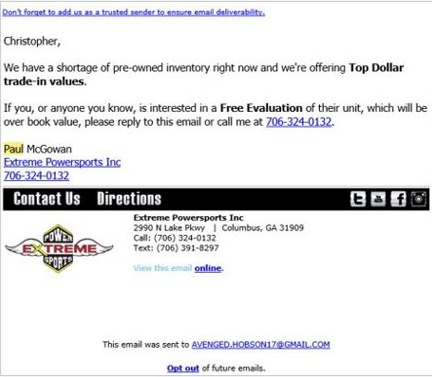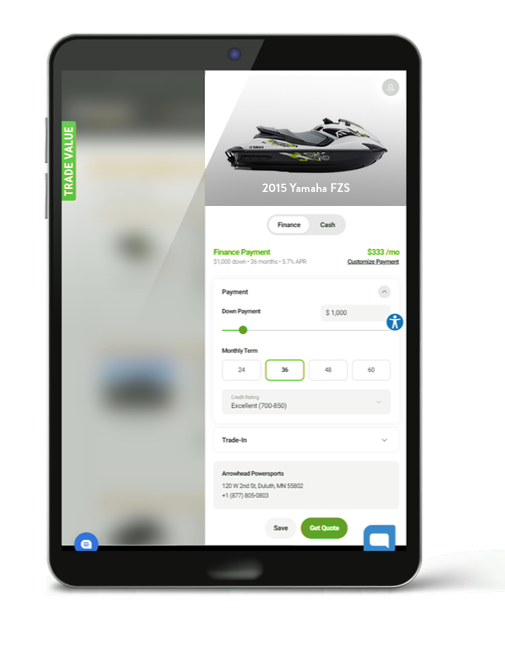
The consumer experience matters—now more than ever before. In the day and age of instant consumer gratification, your customers have nearly endless shopping options and limited patience to put up with businesses that don’t meet their high expectations. The only thing that differentiates your dealership from your competitors—whether across the street, across the country or across the globe—is the experience that you give your customers.
The Shift in Consumer Expectations
With the rise of online shopping and fast, easy shipping and delivery options, your customers can buy just about anything online, major purchases included, with the click of a button. Especially in recent years, due to global market changes and the emergence of major online retailers, the demand for these types of digital experiences continues to expand. It has crossed industry and business boundaries to include cars, boats, recreation vehicles, outdoor equipment, powersports and more.
These new consumer preferences aren’t a passing fad or a blip in global buying trends. Quite the contrary—they’re here to stay. In fact, the majority of consumers who have bought into digital buying experiences expect these options to persist. As much as 70% of today’s consumers believe that brands need to offer seamless, connected buying experiences in order to win their business. What’s more, 72% of shoppers expect personalized experiences from their vendors, and 85% say that experience matters as much as the product or service itself.
While this trend toward ever-expanding shopping alternatives and an emphasis on experience might seem like bad news for smaller brick-and-mortar dealerships, it creates a window of opportunity to grow revenue and expand your business. If you can establish your brand as one that treats consumers right and gives them the shopping experience they expect, you can reach more consumers and increase sales, both online and in-store.
This article will give you an in-depth look at the modern consumer path to purchase. It will provide foundational information, strategies and best practices to help your dealership adapt to increase customer loyalty, grow your business and take advantage of new opportunities in a changing retail landscape.
The Consumers Are Always Right
 The auto and related industries had been trending toward digitization for years. It took a global pandemic to accelerate the process that consumers and forward-thinking companies had already put in place, but the always-adapting dealer adapted yet again. With business being shuttered and more consumers preferring to stay (and shop) at home, dealerships implemented measures to meet changing consumer expectations, including easy digital purchase processes and convenient options for delivery.
The auto and related industries had been trending toward digitization for years. It took a global pandemic to accelerate the process that consumers and forward-thinking companies had already put in place, but the always-adapting dealer adapted yet again. With business being shuttered and more consumers preferring to stay (and shop) at home, dealerships implemented measures to meet changing consumer expectations, including easy digital purchase processes and convenient options for delivery.
Years later, as a younger generation becomes the dominant force in the retail market, buying preferences continue to evolve. This generation practically expects the personalization of services like Spotify and Netflix—they want seamless, personalized and transparent shopping experiences. As much as 69% of consumers now expect Amazon-like buying experiences wherever they shop, placing the burden on businesses to change, and opening the door for new retail opportunities.
In addition to (and partly because of) these factors, global supply chains have been overwhelmed in recent years. Slowed production and supply constraints have impacted dealers, in particular, leading to inventory shortages and a scarcity mindset among consumers. This, combined with post-pandemic economic factors, including rapid economic growth followed by inflation, has forced consumers to change the way they think about buying. They are more particular with their purchases and take time to thoroughly research buying decisions. In summary, the way consumers shop has fundamentally changed forever, and dealerships must continue to adapt.
Walking a Mile in the Consumers’ Shoes Along the Path to Purchase
No two consumer paths to purchase are exactly alike. Your customers come to your dealership in an infinite number of ways. Some may see a YouTube video that sparks an interest in picking up a new hobby. Others may start shopping on a competitor’s website and eventually stumble upon your offerings. Still others may input search terms online and find your dealership at the top of the search results page. Because every shopping journey is unique, you need to be aware of every possible touchpoint along the consumer path to purchase.
- Awareness: Need for a unit or service, online search, watching YouTube videos
- Consideration: Scrolling social media, initial website visits, reading online reviews
- Evaluation: Comparing prices and customer reviews, revisiting the website, narrowing down the list of units/parts/repairs
- Purchase: Calculating monthly payments, purchasing online or visiting the dealership
Knowing how your customers make buying decisions can help you custom-tailor strategies that speak to each individual shopper, no matter their preferred path to purchase.
Awareness
Just as consumer shopping behaviors have evolved, the way you generate awareness for your brand has changed too. There’s still a time and place for broad brand messaging, but general marketing has given way to personalization, even when it comes to promoting your brand.
Online Searches and Social Media
When consumers input search terms in a search engine, the brand that pops up at the top of the list has a real competitive advantage. Similarly, when consumers search social media, the brands that speak to them directly are those they choose to follow. Ironically, in an age of endless retail options, creating personal connections and similar search mindsets matters more than ever before.
Search Engine Optimization
Search engine optimization, otherwise known as SEO, is the process of improving your brand’s visibility online. By optimizing your website’s content, including adding keywords that consumers commonly search for, you can influence the search engine algorithms to ensure that you come out on top (literally) in a list of nearly endless online businesses.
In addition to giving your business a distinct advantage, SEO gives your consumers a better buying experience. When you give your consumers up-to-date business listings, informative website content, easy website navigation and fast webpage load times, they stay engaged with your brand and the buying process.
Blogging
Modern consumers want to know anything and everything about the products and services that interest them. They search online for interesting content and develop strong personal connections with brands that they feel are an authority and provide a constant feed of informative information.
Before shoppers ever step foot in your dealership, you can give them a better shopping and buying experience through blogging. A well-written, well-maintained website blog is an invaluable tool to enhance your SEO, drive traffic to your store and give your customers the kind of buying experience they want.
Social Media Marketing
Giving your customers a superior shopping experience doesn’t stop at SEO and helpful website content. Above and beyond using tools to reach customers, you have to position your brand in a way that attracts them to you. Social media marketing lets you speak to customers on a personal level. By posting on your customers’ preferred social channels, you can build relationships with them and promote your brand in a way that isn’t possible through other forms of content and media.
Personalized Marketing
Your customers want a personalized shopping experience. In fact, they expect it. By paying attention to your customers’ previous actions online and collecting their shopper data, you can customize an experience that’s unique for each customer.
Using this online shopping data, you can make personalized offers through email marketing, retargeting ads, and social media marketing. On top of personalizing the purchase path, this kind of marketing helps you build brand awareness and close more sales with customers. In fact, as much as 58% of consumers are more likely to convert when content is based on their previous actions.
Website Data
 Another way to personalize the customer experience is to track website traffic and gather customer data. This practice allows you to know more about each customer and capture their interests, so you can give them the shopping experience they want. It can also help you make smart business decisions about what inventory (and how much of it) to carry. When you know which pages are most visited (and which ones are causing customers to leave), you can make adjustments to your web content and changes to your business practices to better cater to customer demand.
Another way to personalize the customer experience is to track website traffic and gather customer data. This practice allows you to know more about each customer and capture their interests, so you can give them the shopping experience they want. It can also help you make smart business decisions about what inventory (and how much of it) to carry. When you know which pages are most visited (and which ones are causing customers to leave), you can make adjustments to your web content and changes to your business practices to better cater to customer demand.
Consideration
Your website says a lot about your business. What is it telling your customers? Does it tell them that your operations are outdated, or that you stay current with new trends and technologies? Does it communicate your brand message and help you relate to your customers, or is it giving people the wrong impression of your business? Your website content can speak volumes. Make sure that is says all the right things about your business.
Content Marketing
How quickly is your website content capturing customers’ attention? Within a matter of seconds, do your visitors know who you are, what you offer and whether your brand has real value? Every page on your website should answer these primary questions and provide content to keep customers progressing down the path to purchase.
Give your customers captivating, informative content that keeps them interested and engaged. If you don’t give them the content they want, they’ll just find it somewhere else. As much as 98% of consumers have been turned off from a website because of incomplete or inaccurate content.
While your website content can turn your customers away, it also has the power to influence your shoppers to stay on your website and stick with your business when it comes time to make a purchase decision. Establish your brand as a thought leader through helpful educational pieces that appeal to those who are ready to purchase, as well as those who are just learning more about your products and services.
Inventory Listings
Your inventory listings just might be the most important part of your entire website. Your customers want quick, detailed information about each listing, and your product pages should deliver. Provide comprehensive, to-the-point information about brand, dimensions and materials to help each customer make an informed buying decision. Use filters and search functions, and organize your inventory by category and subcategory, to help facilitate a fast, accurate search.
Make sure that your product pages always reflect accurate information about your current listings. There’s nothing more frustrating for a consumer than finding out the unit they want on your website is currently out of stock at your dealership. Your inventory pages are a great place to put SEO keywords, both in the actual content copy and meta descriptions, to help your product pages climb to the top of the search results and catch the attention of consumers.
Website Imagery
Content isn’t the only thing on your website that speaks to customers. The images you use can tell a customer a lot about your business, including whether they want to continue down the purchase path with your dealership. It shouldn’t come as a surprise that shoppers want to see the actual units that you offer. They want to envision themselves enjoying their new purchase, so high-quality photos of all your listings are a must.
Don’t settle for stock images. It might seem like a quick fix, but it’s also a quick way to turn away customers. Take time to include professional images across your website, but especially on your product pages. If you plan to take your own product photos, make sure that they are high quality and high resolution. Prioritize taking photos outdoors, but avoid shadows and busy backgrounds to keep the focus on the products themselves. Add up-close photos of any special features and, when possible, include 360-degree rotatable images that show your inventory from all angles.
Calls to Action
Calls to action (CTAs) are critically important to a good content plan. Well-placed, well-written calls to action can prompt your customers to take the next step in the buying journey and continue down the path to purchase. They give your customers clear direction on what to do next and they are an important part of the personalized purchase experience your customers want.
Be Specific
Avoid being ambiguous with CTAs. The best CTAs are specific and don’t leave any room for interpretation.
Examples:
- Call Today
- Request a Quote
- Schedule a Demo Drive
Be Inviting
Your customers should never be left wondering what to do next. Invite your customers to take specific action using actionable, inviting verbs that create a sense of urgency.
Examples:
- Find Out Why
- Get Pre-Qualified
- Get Today’s Price
Be Brief
Keep CTAs short—two to four words maximum. This is not the time to get overly creative or overly wordy. Give your customers quick, clear direction.
Examples:
- Learn More
- Request a Quote
- Watch Now
Evaluation
With so many buying options, you have to do more to stand out in a crowded marketplace. Use your website and other marketing tools to build trust, create a welcoming community and communicate with customers on their time and terms.
Re-Engaging Return Visitors
The vast majority of customers make multiple return trips to a website before making a purchase, especially when it comes to major or non-essential purchases. In fact, 92% of website visitors don’t make a purchase on their first visit. Your website has the heavy burden of keeping customers interested and engaged. Give them the type of memorable shopping experience that makes them want to come back for more.
You can do this by ensuring a seamless buying experience and displaying inventory based on their personal interests. Empower your customers to pick up right where they left off with their last visit, giving them the ability to easily locate previously viewed inventory and continue down the path to purchase without having to reinput information. These small details put the customer first, making it easier for them to stick with your dealership.
Customer Reviews & Ratings
Modern customers love online reviews. Sure, anyone can post anything about your dealership, at any time (some of which may be misleading or false), but your customers will trust and rely on these reviews to make a purchase decision. In fact, as much as 68% of consumers make purchase decisions based on positive business reviews. Make it easy for them to give you a positive review by giving them all the information they need to quickly complete a review online.
on these reviews to make a purchase decision. In fact, as much as 68% of consumers make purchase decisions based on positive business reviews. Make it easy for them to give you a positive review by giving them all the information they need to quickly complete a review online.
There’s no getting around online reviews. But you can give your customers the best possible experience and follow a few best practices to take control of how they view and review your brand. Follow these guidelines for reputation management at your dealership.
Build Trust
You can build up a strong base of positive customer reviews just by inviting satisfied customers to review your business and their buying experience online.
Improve Search Engine Rankings
Your reviews have far-reaching effects—they even influence your online search rankings. When you generate positive reviews for your business through a strong reputation management plan, you are rewarded with higher search rankings that establish your brand as an authority in the industry.
Create New Content Opportunities
When your customers say great things about your dealership, feature them on your social channels and on your website and other marketing materials. This strategy reinforces your brand’s reputation for giving customers a quality experience and encourages more customers to write positive reviews.
Demonstrate Empathy
Of course, not all customer reviews will be positive. Even the best businesses have unhappy customers on occasion. It’s important to address negative reviews quickly, showing empathy for their concerns and offering solutions to their problems. This approach shows that you stand behind your brand and support all of your customers.
Digital Customer Service
Modern consumers want to connect with businesses. They’re not interested in simply making a purchase and moving on; they want to be part of a community that shares their interests and enthusiasm. You can reach out to customers and create a welcoming community by giving them the resources and platform to pursue their passions.
Live Chat
Give your website visitors the option to chat with you in real time. Personalize communications by calling them by name, answering their questions and talking about their previous interactions with your business and website.
Social Media
Post engaging content on social media and give your customers the opportunity to interact with you on their preferred social platforms. Be quick with response times and comprehensive with your answers to create strong connections between your brand and your customers.
 Responding to every customer email can be a tall task, but it’s also a big part of promoting your brand and building customer trust. Consider automated email marketing to help with the heavy lifting of managing every email. It’s an effective way to engage customers, drive leads and prioritize immediate customer needs.
Responding to every customer email can be a tall task, but it’s also a big part of promoting your brand and building customer trust. Consider automated email marketing to help with the heavy lifting of managing every email. It’s an effective way to engage customers, drive leads and prioritize immediate customer needs.
Purchase
The path to purchase is almost complete. Give your customers all the conveniences of a modern purchase experience, and you can close more sales and create lifelong customers in the process.
Customizable Payment Calculations
 Comparing prices is a natural part of the purchase process, especially in times of economic uncertainty. Unsurprisingly, 96% of consumers compare prices before making a purchase. In modern retail times, comparing prices comes down to navigating a few webpages or scrolling Amazon search listings. Today’s consumers expect the same transparent pricing information when it comes to more major purchases too.
Comparing prices is a natural part of the purchase process, especially in times of economic uncertainty. Unsurprisingly, 96% of consumers compare prices before making a purchase. In modern retail times, comparing prices comes down to navigating a few webpages or scrolling Amazon search listings. Today’s consumers expect the same transparent pricing information when it comes to more major purchases too.
Make the price comparison process easy for your website visitors by giving them clear, upfront pricing information. Give them the tools they need to customize their purchases, including a payment calculator to make the process even easier. This feature allows customers to input credit and down payment information to see if they can afford their dream units. It also streamlines the entire shopping experience, eliminates low-ball offers and filters out customers that aren’t quite purchase ready.
Know Each Customer’s Journey
When your customers finally arrive at your store, be ready to continue the buying experience they already started online. Your CRM should have a record of actions that each customer has already performed, so you can guide them through the final steps of the purchase process. When you give your customers a seamless online to in-store purchase experience, you streamline the entire sales process and eliminate the hassle and frustration that come with reinputting old information.
Conclusion
Experience matters. It matters to customers and it matters for the well-being of your business. In the modern retail environment, it also might be the only thing that differentiates your dealership from your competition. The old ways of retail are evolving, and tomorrow’s businesses need to get on board with modern consumer preferences today to offer personalized, connected, convenient shopping and buying experiences. By understanding the customer journey, offering modern shopping tools and optimizing your website and marketing, you can give your customers the experience they expect and improve your chances of converting potential buyers into loyal, lifelong customers.


